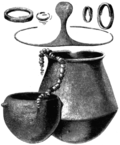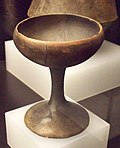Material culture
El Argar was the cultural center of the Early and Middle Bronze Age in Iberia. With an area of 16.000 m² and an estimated population of aroung 5000 inhabitants, it is one of the largest known settlements belonging to the Middle Bronze Age in the peninsula. More than a thousand graves have been found inside the houses themselves. It was strategically located on the top of a flat hill, protected by a wall, inside which rectangular houses of 8-10 m by 2.5 m have been found, as well as other housing estructures with an irregular or circular floor plan. The walls were built of wood and mud, raised on a stone plinth [2] . The roof was made of reeds or branches and mud. The settlement had a complex urban planning that is characterized by the artificial creation of terraces, with an acropolis located at the highest part of the site..
Metallurgy of bronze and pseudo-bronze (alloyed with arsenic instead of tin) was practiced. Weapons are the main metallurgic product: knives, halberds, swords, spear and arrow points, and big axes with curved edges are all abundant, not just in the Argaric area, but also elsewhere in Iberia.
The women at this site were buried with numerous grave goods of silver, treasure that suggests that women held high status in the society. For instance, excavation of Grave 38 began in 2014, [3] and it contains burial goods estimated to be worth tens of thousands of dollars and included a diadem. The burial was found below a unique building, when compared to the others excavated. The building above the grave appears to be a great hall, with benches along the sides that could seat up to 60 people. This suggests that the hall was used for politics. The grave and hall have been radiocarbon dated to approximately 1700 BC. [4]
This page is based on this
Wikipedia article Text is available under the
CC BY-SA 4.0 license; additional terms may apply.
Images, videos and audio are available under their respective licenses.
















